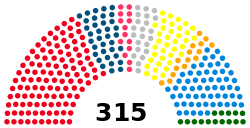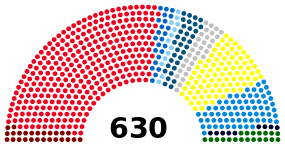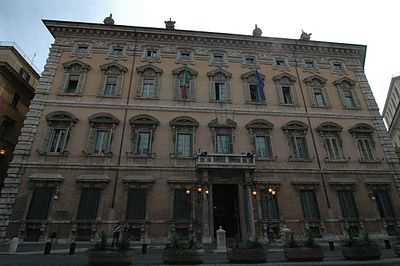Italian Parliament
| Italian Parliament Parlamento Italiano | |
|---|---|
 | |
| Type | |
| Type |
Bicameral |
| Houses |
Senate of the Republic Chamber of Deputies |
| Leadership | |
President of the Senate | |
President of the Chamber | |
| Structure | |
| Seats |
945 + Senators for life |
 | |
Senate of the Republic political groups |
Government (172)
Opposition Parties (137)
|
 | |
Chamber of Deputies political groups |
Government (409)
Opposition Parties (221) |
| Elections | |
Senate of the Republic last election | 24–25 February 2013 |
Chamber of Deputies last election | 24–25 February 2013 |
| Meeting place | |
|
Chamber of Deputies—Palazzo Montecitorio Senate of the Republic—Palazzo Madama | |
| Website | |
| http://www.parlamento.it | |
Italian Republic
|
|---|
 |
| This article is part of a series on the politics and government of Italy |
| Constitution |
|
|
Legislature
|
|
| Foreign relations |
|
Related topics |
|
Politics portal |
The Italian Parliament (Italian: Parlamento Italiano) is the national parliament of the Italian Republic. It is a bicameral legislature with 945 elected members (parlamentari). It is composed of the Chamber of Deputies, with 630 members (deputati), and the Senate of the Republic, with 315 members (senatori). Both houses have the same duties and powers, and the Constitution does not make distinctions between them. But, because the President of the Senate stands in the role of Head of State when the President of the Republic needs to be replaced, the Senate is traditionally considered the upper house.
Since 2005, a party list electoral law is being used in both houses. A majority prize is given to the coalition obtaining a plurality: at national level for the Chamber, at regional level for the Senate. This system was declared to be unconstitutional by Italy's Constitutional Court in 2013.
Function of the Parliament
The Parliament is the representative body of the citizens in the republican Institutions, and act accordingly.
By the Republican Constitution of 1948, the two Houses of the Italian Parliament possess the same rights and powers: this particular form of parliamentary democracy (the so-called perfect bicameralism) has been coded in the current form since the adoption of the Albertine Statute and resurged after the dismissal of the fascist dictatorship of the 1920s and 1930s during World War II.
The two Houses are independent from one another and never meet jointly except under circumstances specified by the Constitution. The House of Deputies has 630 members, while the Senate has 315 elected members and a small number of life senators: former Presidents of the Republic and up to five members appointed by the President for having contributed to the Country high achievement in the social or scientific field. As of May 2013 there are three life senators (of whom one is former president).
The main prerogative of the Parliament is the exercise of legislative power, that is the power to enact laws. For a text to become law, it must receive the vote of both Houses independently in the same form. A bill is discussed in one of the Houses, amended, and approved or rejected: if approved, it is passed to the other House, which can amend it and approve or reject it. If approved without amendments, the text is promulgated by the President of the Republic and becomes law. If approved with amendments, it is passed back to the originating House, which can approve the bill as amended, in which case the law is promulgated, or reject it.
The Parliament votes support to the Government,[1] which is appointed by the President of the Republic and, since 1994, usually led by the leader of the coalition winning the elections, while during the so-called First Republic it was chosen by the secretaries of major parties. The Government must receive a support vote by both Houses before being officially in power, and the Parliament can request a new vote of support at any moment if a quota of any House so requests. Should a Government fail to obtain a vote, it must resign; if it does, either a new Government is formed or the President of the Republic can dissolve the Houses and new elections are held.
The Parliament in joint session of both Houses elects the President of the Republic (in this case, 58 regional delegates are added), five (one third) members of the Corte Costituzionale and one third of the Superior Council of Judiciary. It can vote to decide an accusation of high treason or attack to the Constitution against the President of the Republic (though this situation has never occurred).
Electoral system
The current Italian Electoral Law, approved on December 14, 2005, is based on party-lists representation with a series of thresholds to encourage parties to form coalitions. It replaced an Additional Member electoral system which had been introduced in the 1990s.
The block voting system is nationwide-based for the House, and regional-based for the Senate. Italy is divided into a certain number of districts for the Chamber of Deputies, whereas each Region elects its senators. Each district is assigned a number of seats proportionate to its total of the population of Italy. The winning coalition receives at least 55% of the seats on national level in the House, and on regional level in the Senate, while the remaining seats are proportionally divided between minority parties. For the House, seats won by each party are then allocated at district level to decide the elected candidates. Candidates on the lists are ranked in order of priority, so if a party wins for example ten seats, the first ten candidates on its list receive seats in parliament.
The law officially recognizes coalitions of parties: to be part of a coalition, a party must sign its official program and indicate its support for the coalition's candidate to the prime-ministership.
The 2005 electoral law was declared unconstitutional by the Constitutional Court of Italy at the end of 2013, as it did not meet some constitutional requirements concerning the right of voters to effectively express their will through vote.[2][3] This implies that the current Parliament of Italy (ruling since 2013) was formed with an electoral law that does not comply with Italy's fundamental law, hence does not meet the citizen's fundamental right of vote.
Overseas constituency
The Italian Parliament is one of the few legislatures in the world to reserve seats for those citizens residing abroad. There are twelve such seats in the Chamber of Deputies and six in the Senate.[4]
Membership
Senate
The current membership of the Italian Senate, following the latest political elections of 24 and 25 February 2013:
| Coalition | Party | Seats | ||
|---|---|---|---|---|
| Pier Luigi Bersani: Italy. Common Good |
Democratic Party (PD) | 111 | ||
| Left Ecology Freedom (SEL) | 7 | |||
| South Tyrolean People's Party (SVP) | 2 | |||
| Trentino Tyrolean Autonomist Party (PATT) | 1 | |||
| Union for Trentino (UPT) | 1 | |||
| The Megaphone – Crocetta List (IM-LC) | 1 | |||
| Total | 123 | |||
| Silvio Berlusconi: Centre-right coalition |
The People of Freedom (PdL) | 98 | ||
| Lega Nord (LN) | 18 | |||
| Great South (GS) | 1 | |||
| Total | 117 | |||
| Beppe Grillo: Five Star Movement (M5S) | 54 | |||
| Mario Monti: With Monti for Italy | 19 | |||
| Associative Movement Italians Abroad (MAIE) | 1 | |||
| Aosta Valley (VdA) | Valdostan Union (UV) | 1 | ||
| Total | 315 | |||

Chamber of Deputies

| Coalition | Party | Seats | ||
|---|---|---|---|---|
| Pier Luigi Bersani: Italy. Common Good |
Democratic Party (PD) | 297 | ||
| Left Ecology Freedom (SEL) | 37 | |||
| Democratic Centre (CD) | 6 | |||
| South Tyrolean People's Party (SVP) | 5 | |||
| Total | 345 | |||
| Silvio Berlusconi: Centre-right coalition |
The People of Freedom (PdL) | 98 | ||
| Lega Nord (LN) | 18 | |||
| Brothers of Italy (FdI) | 9 | |||
| Total | 125 | |||
| Beppe Grillo: Five Star Movement (M5S) | 109 | |||
| Mario Monti: With Monti for Italy |
Civic Choice (SC) | 37[lower-alpha 1] | ||
| Union of Christian and Centre Democrats (UDC) | 8 | |||
| With Monti for Italy (SC abroad) | 2 | |||
| Total | 47 | |||
| Associative Movement Italians Abroad (MAIE) | 2 | |||
| South American Union Italian Emigrants (USEI) | 1 | |||
| Aosta Valley (APF) | Edelweiss (SA) | 1 | ||
| Total | 630 | |||
As illustrated by the bars above, the Bersani-led coalition won the plurality in the nationwide election with a 0.4% lead over the nearest coalition, and thus - as defined by the Italian election law - was granted a majority bonus equal to an automatic 55% of the seats in the Chamber of Deputies.
See also
| Wikimedia Commons has media related to Parliament of Italy. |
Notes
- ↑ Incl. the Union for Trentino (UPT) party leader Lorenzo Dellai, who decided not to submit his own party list for the Monti-coalition, but opted to be a direct part of the Civic Choice list.[5][6]
References
- ↑ Against the mingling of confidence vote and legislative process see (Italian) in Mondoperaio online, 2 aprile 2014.
- ↑ "Italy's top court rules electoral law breaches constitution". Reuters.
- ↑ "Giudizio di legittimità costituzionale in via incidentale". Corte Costituzionale della Repubblica Italiana.
- ↑ "Presentazione delle candidature per la circoscrizione estero" [Submission of nominations for the constituency abroad]. Ministry of the Interior of Italy.
- ↑ "List Monti in Trentino: Lorenzo Dellai and candidates from Societa' Civile" (in Italian). l'Adige. 9 January 2013. Retrieved 28 February 2013.
- ↑ "Regional elections, the idea of coalition wins" (in Italian). l'Adige. 26 February 2013. Retrieved 28 February 2013.
- Gilbert, Mark (1995). The Italian Revolution: The End of Politics, Italian Style?.
- Koff, Sondra; Stephen P. Koff (2000). Italy: From the First to the Second Republic.
- Pasquino, Gianfranco (1995). "Die Reform eines Wahlrechtssystems: Der Fall Italien". Politische Institutionen im Wandel.
External links
| ||||||||||||||||||||||||||||||||||||||||||||
| ||||||||||||||||||